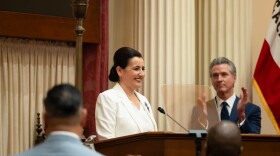San Diego County is home to about 80,000 Iraqis, and it could begin to see more.
Eight weeks ago, El Cajon's Mark Arabo began hearing from the local Chaldean community that their relatives back home in Iraq were being displaced or violently killed by Islamic State, or ISIS, militants. The extremist group is targeting religious minorities, including Chaldean Catholics, in a brutal offensive aimed at establishing a Muslim state across Syria and Iraq. Arabo, a member of the Chaldean Church and president of a San Diego County group that represents predominantly immigrant convenience store owners, wants Iraqi minorities airlifted from the country and set on a quick path to asylum.
Arabo is working with Democratic Rep. Juan Vargas of San Diego, the White House and the United Nations to clear that path. Arabo sounded the alarm that led to a House resolution urging action, and to airstrikes and humanitarian aid ordered by President Barack Obama, said Vargas' chief of staff, Tim Walsh.
"I'd call Mark a hero. That's what I'd call him," Walsh said. "Mark was one of the earliest ones shouting from the mountaintop, saying we have to do something. If we find the right solution, Mark has saved a lot of lives."
Arabo said a three-day visit to the U.N. last week helped secure international humanitarian aid, sanctions against ISIS supporters, and promises from Australia, France and Sweden to begin taking in Iraqi asylum-seekers. The United States has yet to make any promises on granting asylum. It has accepted more than 74,000 Iraqi refugees since 2003 and will continue to do so. But there's a limit to how many it will take each year. Arabo wants the U.S. government to set the cap aside (or move it up) and get people out of the country now.
Here's how that might work.
Decide if they're eligible for asylum or refugee status
Those applying for asylum and those applying for refugee status are seeking the same thing: protection from persecution based on race, religion, nationality, membership in a certain social group or political opinion. Individuals in both groups must make the case they've experienced or will experience such persecution. Applicants must pass a background check to certify they aren't a threat to the United States and haven't participated in persecuting others.
The asylum category typically classifies those who have already fled to the United States and are appealing to stay, like the Central American children showing up at the U.S.-Mexico border. The refugee category refers to those who are applying from abroad, usually from refugee camps.
Iraqis, particularly religious and ethnic minorities, are considered a priority for the U.S. refugee program.
Determine whether there are enough slots for them
There is no limit on the number of individuals to whom the U.S. can grant asylum. The asylum policy is there in case of extreme need, and an immigration judge makes that call.
There is, however, a cap on the number of individuals who can gain refugee status in the United States each year. The president, who consults with Congress on the matter, sets the overall ceiling and carves out allotments for different regions.
President Barack Obama set the cap at 70,000 for fiscal 2014, which ends Sept. 30. He wanted to allow up to 33,000 refugees from "Near East and South Asia," which includes Iraq.
In recent years, that allotment has largely been split among those fleeing Iraq, Iran and Bhutan. Last fiscal year, 19,488 Iraqis came to the U.S. as refugees, filling about 60 percent of the region's slots.
If there aren't enough slots, find a way to make more
Arabo said Iraq's unofficial share of the refugee allocation isn't enough. He wants the president to raise the ceiling or shift around allocations and use reserves (sometimes spots are set aside or left over) so Iraqis have a greater likelihood of getting refugee status.

"I think we have a moral obligation to offer Iraqi Christians and Yazidis (the predominantly Kurdish religious minorities ISIS has exiled to Mount Sinjar) a home," Arabo said.
Raising the ceiling would likely have to come with additional appropriations. The government spends $1,875 to help each refugee (and asylee) with the initial costs of resettling. New arrivals also qualify for state welfare programs such as CalWORKS and CalFresh, also called food stamps.
Shifting around allotments, which is possible mid-year, wouldn't cost more but could hurt people in other regions. For example, there are just 5,000 spots for people trying to leave Central and South America this year. While those granted asylum don't eat into regional allotments, the 62,000 children migrants from Central America who have come to the border seeking asylum this year suggest plenty of people are vying for those spots.
"It feels as though we're in a unique time where there are a lot of needs throughout the world, and all of these have to be considered when we look at just one region," Walsh said. "I think that's part of the complexity of this."
Or, forget the slots altogether and send some planes
Arabo has also suggested Obama take executive action the way President Gerald Ford did when Saigon fell in 1975. Ford's administration evacuated 130,000 Vietnamese from the country and resettled them in the United States, many here in San Diego.
Walsh said Vargas is considering all options.
"We're looking at all of them, and when Congress is in session that first week of September, my hope is that there's a great many solutions — that Rep. Vargas isn't the only one proposing them — and that we can find the one that meets the least resistance and get it passed as soon as possible," Walsh said.








